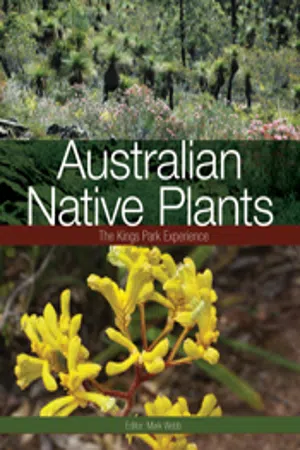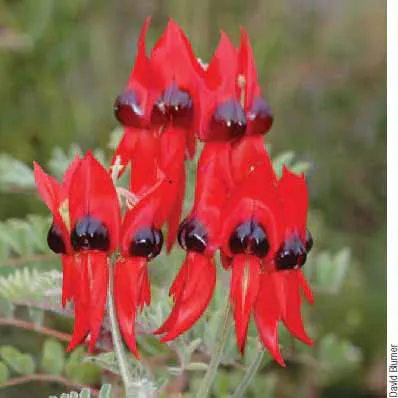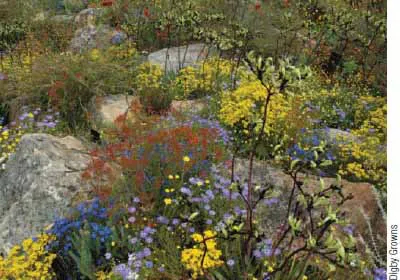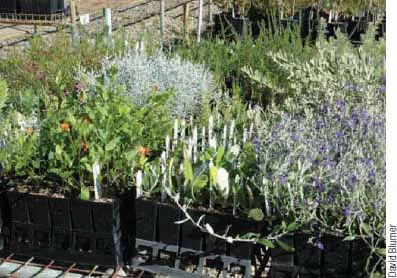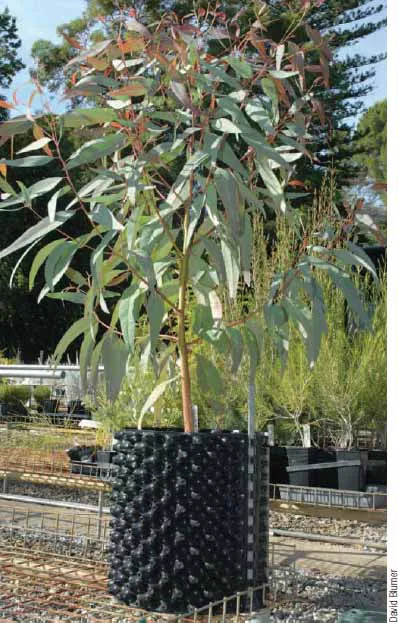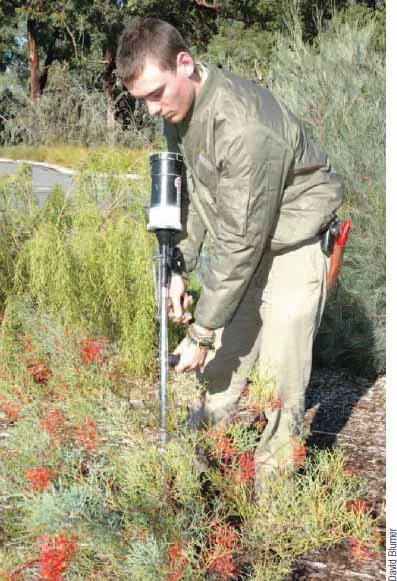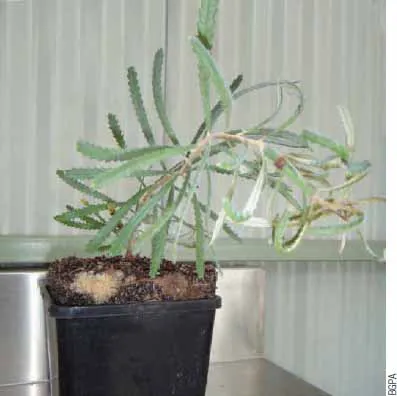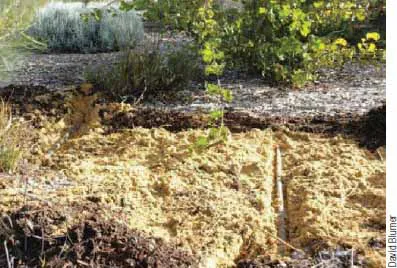![]()
Chapter 1
Growing Australian native plants
Mark Webb and Grady Brand
Australian plants need normal horticultural care and attention for optimum results. To achieve good plant growth, desirable form and strong flowering, many species require regular irrigation, pruning and applied fertiliser. Others, however, especially those in the Proteaceae family such as grevilleas and hakeas, require minimal ongoing care and attention once established.
Swainsona formosa growing in Kings Park.
Most Western Australian native plants grow best on well-drained, slightly acid soils and in locations that experience warm, dry summers and cool, moist winters. They prefer a sunny aspect and soils free of disease, especially the fungal diseases phytophthora and armillaria.
Plants that are indigenous to an area usually give the best results in that location. They also have the advantage of being very attractive to local wildlife. However, many Australian plants grow well in a range of environments and most wildlife adapts readily to introduced plants.
Plants from different regions of Western Australia growing under the same environmental and horticultural conditions in Kings Park.
When to plant
Australian native plants can be planted at any time of year provided they receive adequate water during warm to hot weather. The best time to plant in areas with winter rainfall is from early autumn to late spring. In areas that experience prolonged periods of cold weather or light frosts, it is preferable to plant after mid-spring.
Healthy seedlings ready for planting.
Planting
Generally, the younger the seedling to be planted, the better its establishment will be, provided it is hardened off and has a well-developed root system. If plants are held in pots for too long before being transplanted, they can become root-bound and may not grow to full size. Root-bound plants can also die unexpectedly up to several years after planting, especially following periods of prolonged hot weather. Purchasing plants from a reliable and accredited supplier will help to ensure a long-lived and healthy plant.
For large shrubs and trees, best long-term results are achieved by seeding directly into a three-dimensional air root-pruning pot (25 to 50 litres) and then planting out when the shrub or tree reaches a suitable size.
A healthy eucalypt in a three-dimensional air root-pruning pot ready for planting.
Make the planting hole at least 50 per cent wider and deeper than the pot; remove the seedling or plant from the pot, loosen the root ball before planting and then backfill with local soil. Make sure the stem of the plant is at the same level in the soil as it was in the pot, and water the plant into its new position.
In heavy or very compacted soils, break up the soil and only plant species that will tolerate such conditions. In these and other difficult situations, mounding with a free-draining sandy soil is a proven technique for successfully growing a wider range of Australian plants. The mound should be 30 to 50 centimetres above the existing soil line.
It is important to investigate and document any previous use of the site that has impacted on the soil, such as compaction from vehicles or high levels of residual nutrients (especially phosphorus) from other horticultural activities. These impacts can negatively affect plant growth and need to be factored into site design and plant selection.
Fertiliser
Most Australian native plants grow naturally in soils with low levels of residual phosphorus. When purchasing a complete fertiliser that contains a range of nutrients, choose one that has low or nil phosphorus and apply it according to the instructions on the label.
Controlled or slow release synthetic fertilisers are usually more expensive than fast release fertilisers per unit of available nutrient, but they are easy to use and more forgiving if accidentally over-applied.
Applying slow release fertiliser.
Fresh animal manures are not recommended for most Australian plants. Some, especially fresh chicken manure, can damage plants and also contain high levels of available phosphorus. Composted organic matter low in phosphorus can be used on Australian plants and has the added value of supplying organic material that provides many benefits to the physical, chemical and microbiological environment of the soil.
Using fast release fertilisers requires experience and care. If excessively applied on young seedlings or even on older plants, fast release fertilisers (especially those that contain higher concentrations of nitrogen or potassium salts) can burn the roots causing leaf wilting, leaf burning and even plant death. Always apply any fertiliser according to the instructions on the label.
If the plant has been bought from a reliable supplier, there should be enough slow release fertiliser in the potting mix for the plant to thrive for several weeks after planting before additional fertiliser has to be applied.
Most Australian plants don’t need added fertiliser for maintenance growth, but for many species, application of a slow release or complete fertiliser with low or nil phosphorus in late spring to early summer, or after flowering, will improve plant vigour and flowering display. Plants grown in pots will usually require more regular fertilising than plants grown in the ground.
Many Australian plants are adapted to growing in nutrient-deficient soils and some have developed mechanisms such as proteoid roots (clusters of roots near the soil surface) to extract soil phosphorus at very low concentrations. The regular application of fertiliser containing phosphorus, or growing plants on land previously fertilised for other crops, can result in too much phosphorus being available to some plant species. Phosphorus toxicity is well known in banksias but it can also occur in other genera in the Proteaceae, as well as genera in the Rutaceae, Fabaceae, Mimosaceae, Myrtaceae and Haemodoraceae. Phosphorus toxicity symptoms vary but can include slow growth, yellowing of the youngest leaves (a symptom which may be confused with iron deficiency), burning of the leaf edges, reddening and then death of the older leaves. However, for most banksias that suddenly yellow and die, disease is usually the more likely cause, not nutrient toxicity.
Proteoid or cluster roots on Banksia attenuata.
For Australian plants that grow naturally on acid soils, growing them in alkaline soils or irrigating with alkaline water can be very challenging. Lime-induced chlorosis or iron deficiency typically shows up as a yellowing of the youngest leaves and may be corrected in the short term by application of iron chelate. Foliar applications are quicker acting than soil applications but the effect may only last a few weeks or months. Slowly changing the soil pH to accommodate the more acid-loving plants can be done but is not a straightforward or quick process. Using a less sensitive cultivar of the same species can sometimes overcome iron deficiency problems, but if the symptoms persist, grow the plant in a pot using a high quality potting mix, on an alkaline-tolerant rootstock if one is available, or try another native plant better suited to alkaline conditions.
Watering
Australian native plants have varying water requirements and an understanding of their natural environment is a good guide as to how they will perform in a cultivated situation. Many plants in the Proteaceae, such as grevilleas or banksias with their proteoid or cluster root systems, usually need supplementary watering only during establishment and in very hot weather.
Others, including boronias such as Boronia megastigma and B. heterophylla from the cooler south-west forest regions of Western Australia, require regular watering to survive and thrive. These plants die within a few days if water-stressed and are commonly known as ‘drop-dead’ plants. While they can be grown in-ground, if irrigation is likely to be irregular or limited, then growing them in self-watering pots can give better medium term results. In contrast, B. crenulata, also from the south-western region of Western Australia, is relatively hardy and can survive in-ground with less regular watering.
Increasingly, grafting site-specific plants onto more vigorous or tolerant rootstocks such as B. megastigma on B. clavata is extending the range of locations in which more difficult to grow or sensitive species can be grown.
After planting, keep the plants well watered, but not waterlogged, until they have established. Be especially diligent in applying enough water in early autumn and late spring, as plants can quickly dry out after only a few days of unseasonably hot weather, especially on well-drained soils.
Plants with similar watering requirements should be grouped together for ease of management, although the need to do this can be overcome to some degree if trickle irrigation, with different output drippers or mini-sprinklers on the same line, is used on plants with varying water requirements. On difficult-to-wet or non-wetting soils, regularly applying a wetting agent and irrigating at a slower rate will improve water penetration.
An example of sub-surface trickle irrigation (the soil has been removed).
In Kings Park, permanent display beds with excellent plant growth and flowering have been achieved by using specialised sub-surface irrigation. In these situations, the drip line is located 5 centimetres underground, with in-line drippers at 30 centimetres and in rows 0.5 metre to 1 metre apart, with the soil backfilled. Once plants have been established...
